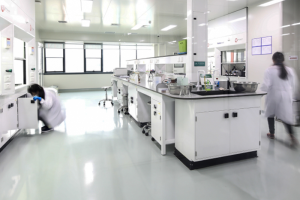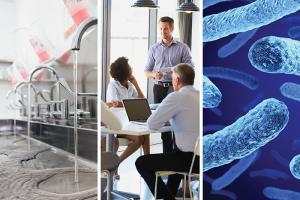Modernizing elevator systems in health care facilities
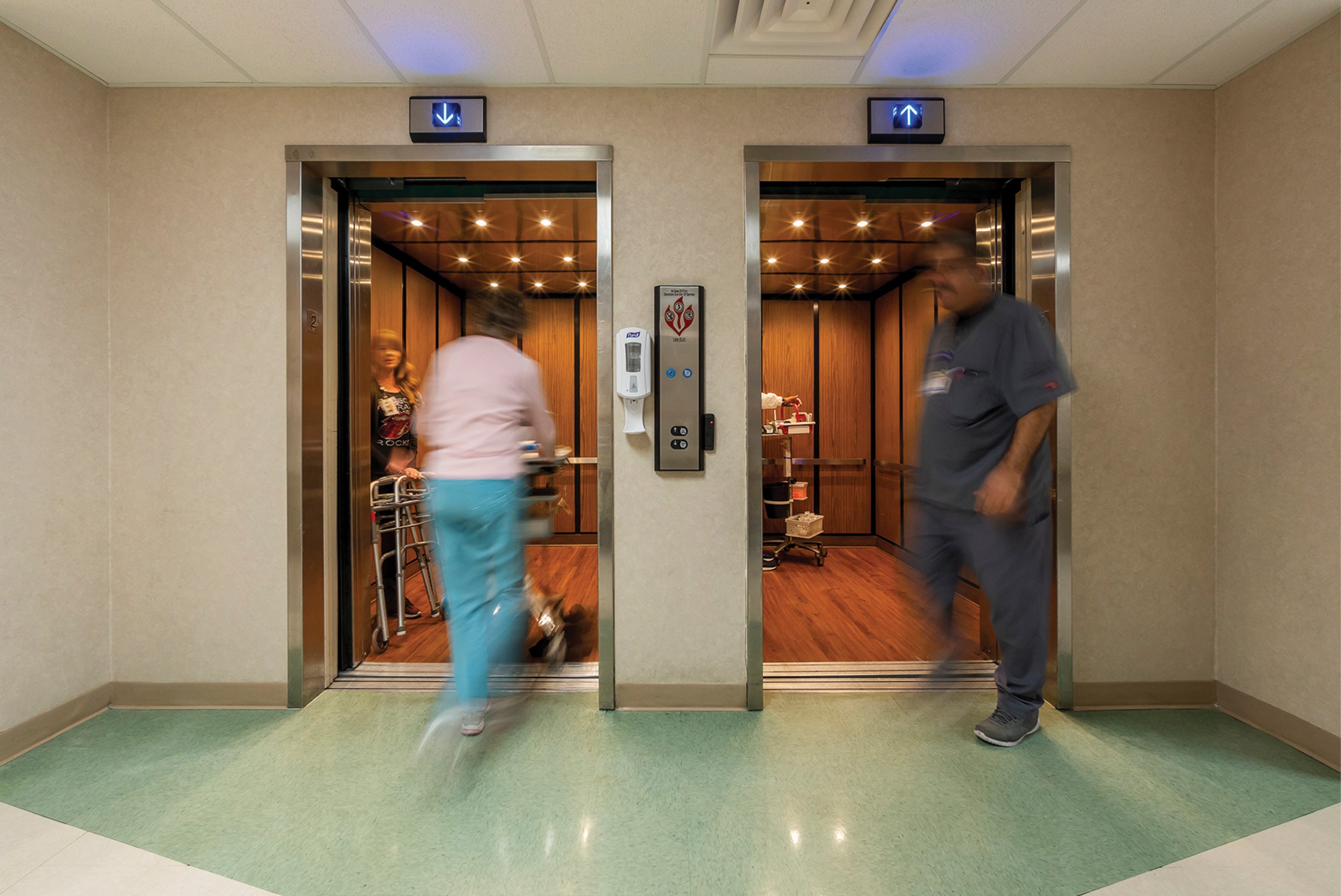
The elevator lobby is the most visible part of a hospital’s elevator system.
Image courtesy of Henderson Building Solutions
The ability of elevator systems to provide reliable service is crucial to ensure the most efficient health care possible. Often, the visitor or garage elevators are among the first touch points that patients and their families have with the health care facility, and a poor experience negatively affects the assessment of the patient care experience.
In urban areas, vertical expansion requires the ability to move critical patients and staff quickly and smoothly from floor to floor in dedicated cars. In extreme emergencies, first responders take control of elevators to utilize them for patient evacuation and threat isolation.
Major elevator components
Elevators are a function of designed parts combined into a system. These parts come from every facet of building construction and are not just limited to the elevator contractor’s equipment. In general, elevator systems are broken into five major components that are made up of diverse features from every trade, including:
Lobby. Elevator lobbies are the most visible parts of the system. These can be simple, open areas in low-rise buildings or complex areas of refuge, complete with communication equipment and pressurization systems for high-rise buildings. The most obvious components of elevator lobbies are the hoistway doors, call station and elevator fixtures.
The fixtures indicate the direction of travel of the elevator and may include a position indicator to tell what floor the elevator is currently on. Code requires different levels of treatment based on use. Features that should always be in an elevator lobby include smoke detection, fire protection and lighting. In some high-rise systems, the elevator lobby may become its own smoke compartment, which may necessitate installing 2-hour walls and fire door systems.
Cab. Everyone is used to seeing elevator cab interiors that feature lights, interior finishes, operating panels and doors. The cab also includes exhaust fans that typically recirculate air in the hoistway. All interior items sit within the carriage frame and are connected to the guide rails with roller or slide guide devices.
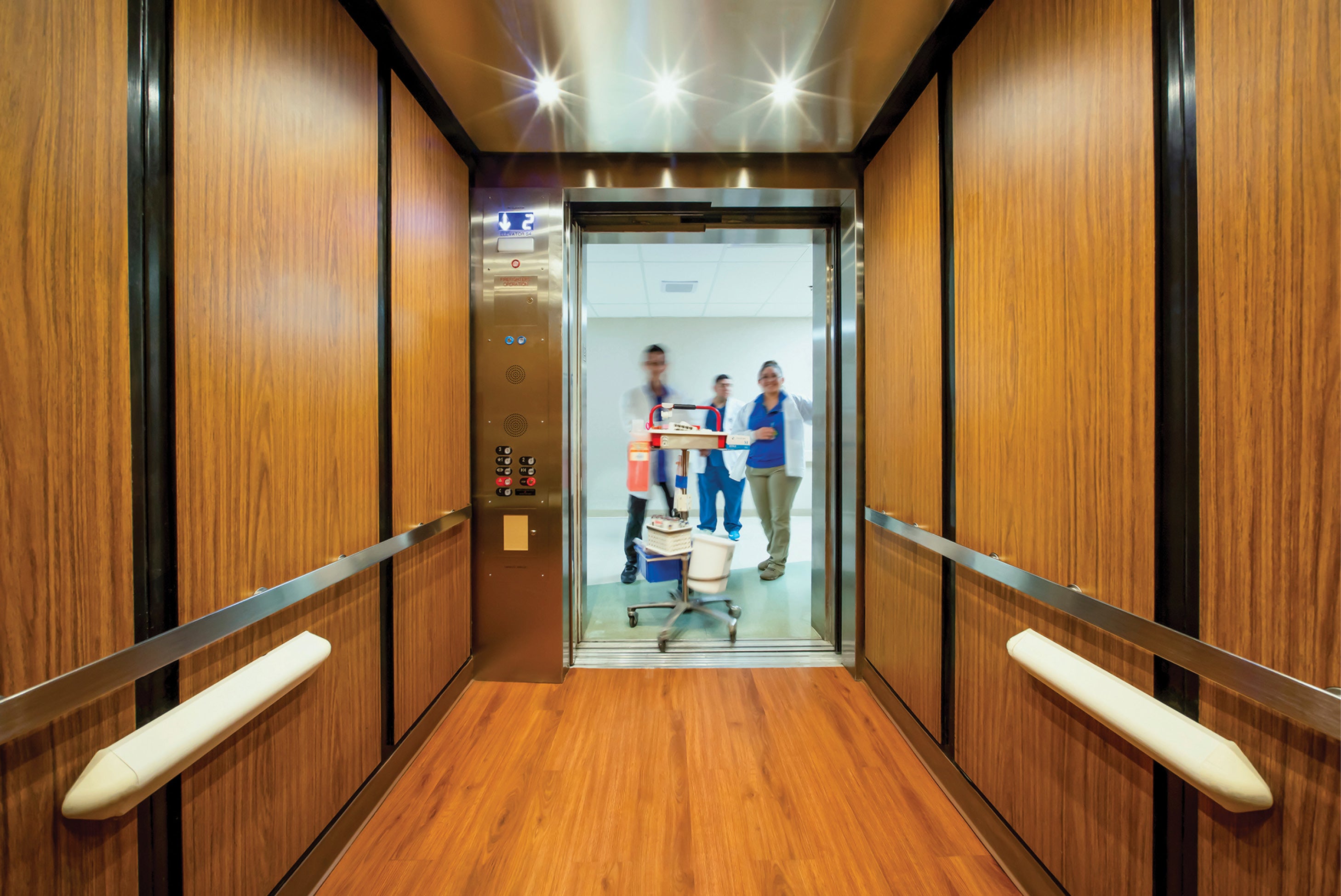
Elevator cabs feature lights, interior finishes, operating panels, exhaust fans and doors.
Image courtesy of Henderson Building Solutions
The cab and hoistway doors are operated by a door operator system that is mounted on top of the cab. Also contained in the hoistway are the elevator landing devices and hitch or jack plates. All functions of the cab are connected by the elevator traveling cable, including power, elevator operations and additional operations wiring for security devices, communications and auxiliary functions.
Hoistway. The elevator hoistway or shaft is the area in which an elevator moves. It is always separated from public access by hoistway access doors. This can be a glass enclosure in the case of some atrium elevators. More commonly, it is a fire-rated enclosure. A single hoistway is typically permitted to hold up to three elevators without being divided. It contains separator beams, elevator wiring duct from the machine room to the elevator control points and elevator rails.
In the case of traction elevators, deflector sheaves and other equipment are often located at the top of the hoistway. Fire protection and detection systems are sometimes overlooked items that require updating. Hoistway pressurization or ventilation systems may also be installed depending on local codes and the code the elevator was built under. Elevator ventilation systems have been altered many times through code cycles and often require modification as part of a modernization.
Pit. The elevator pit is located at the bottom of the hoistway. The most common elevator pit is 3 to 5 feet deep and accessed via the hoistway door on the lowest level of travel for the elevator. There are exceptions where elevator pits are accessed via walk-in doors if there are levels below the lowest level of access, as well as pits that are multiple stories in depth. Elevator pits are required to be sealed against groundwater. The sump pump or drain systems located in the pit are designed to eliminate water that would enter the elevator hoistway or pit due to release by the fire protection system.
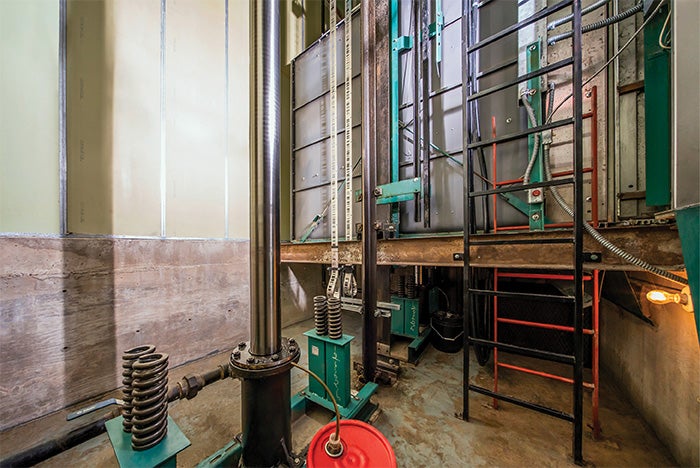
An elevator pit modernization underway with the new elevator equipment installed, but work by others not yet complete.
Image courtesy of Henderson Building Solutions
Equipment found in the elevator pit includes pit buffers that are designed to slow the descent of the elevator in case the elevator falls. Traction elevators will have buffers for the counterweight installed in the pit as well. Elevator pit switches prevent movement of the elevators while someone is working in the pit. Hydraulic elevators also have a jack installed in the pit, either a standard jack or a hole-less hydraulic type. Much older elevator systems that use a physical selector type of landing device will have a return sheave installed in the pit as well. Required non-elevator equipment in the pits will include pit access ladders, service receptacles, lights and sump pump systems.
Machine room. The elevator machine room contains the heart of the elevator system and equipment. A typical machine room holds the elevator drive machine (hydraulic or traction) and the elevator controller. For larger elevator groups in older systems, there are usually group controllers as well. In addition to the elevator items in the machine rooms, there are several requirements for architectural features that are different depending on the use of the elevator and the classification of the building. Mechanical, electrical, plumbing and fire protection (MEPF) requirements for elevators can reach far beyond the elevator machine room and cause much more expansive upgrades.
The most common elevator type found in low-rise buildings is the hydraulic elevator system. Hydraulic elevators are the least complex elevator types. They require a hydraulic jack that is filled with fluid to cause the elevator to rise and be evacuated of fluid to let the elevator fall. While these elevators can be as many as 10 floors high, they commonly service five or fewer floors. Hydraulic elevators are regularly used for high-weight capacity applications.
The second most common elevators are standard traction elevators, also known as roped or electric elevators. They generally are used in applications of four floors or greater and are available in geared traction for low- and mid-rise applications or gearless machines for high-rise applications.
The newest elevator type on the market is the machine room-less (MRL) elevator. These are available in traction and hydraulic types and can reduce the footprint that elevator systems require by moving the elevator drive machines to the elevator hoistway.
There are many considerations to explore before committing to installing an MRL system. The most common argument for changing to a MRL is space savings. However, it is often found that the room being abandoned is not revenue-generating space and is already set up with required access for servicing the elevator controller and machine, or the controller still ends up occupying the room, rendering it unusable for storage or income-generating purposes.
Traction MRL machines must be built more compactly and typically are less durable than their standard traction elevator counterparts. Hydraulic MRLs have limited options for heat and odor rejection, and often require a dedicated hoistway conditioning system. While MRL units often cost less on the front end, they are typically much costlier to own over an elevator’s expected lifetime.
Modernization projects
Prior to starting an elevator modernization project, health facilities professionals must determine whether their elevators are ready for modernization. Because elevators typically take several weeks to modernize, other elevators in the vicinity must be ready to carry additional ridership for the duration of a modernization.
These assessments are usually undertaken by an independent third party that is familiar with elevator codes (i.e., the American Society of Mechanical Engineers’ ASME A17.1, Safety Code for Elevators and Escalators) and requirements of the local authority having jurisdiction (AHJ). They should also be well-versed in applicable International Building Codes and National Fire Protection Association standards, as they apply to existing and new construction in health care environments. Additionally, they should be knowledgeable about infection control measures during construction projects and the unique challenges of working with vertical transportation systems.
These assessments consider the existing service conditions and service contract, the condition of the existing equipment and the building services associated with each elevator. By examining the service contract closely, the third party will be able to identify any clauses contained in the contract that may impact modernization options. Additionally, they can identify gaps in the service that is required by the contract and services being rendered for the site.
The third party will also be able to properly notify the existing contractor of the intent to competitively bid out the modernization, which is commonplace on such projects. If the existing service contractor does not win the modernization project, their contract is suspended for each elevator group as it is removed for modernization. Typically, the contractor that is awarded the modernization project will provide the routine service for the entirety of the warranty period.
The initial assessment will also make every attempt to identify service needs that can affect the capability of the elevators to remain in service with additional load added. Issues are often related to doors and door hardware but can be as serious as rope or other safety equipment that is severely worn and will not last through modernization of another car. This assessment will also help identify the order in which the elevators should be modernized, whether due to service-related issues or due to the physical location of existing equipment that would need to be moved out in a certain order to permit new equipment installation.
As the service-related items are being cleared, specifications and drawings for the elevator modernization project should be assembled. At this time, it is also important to start the bidding documents for elevator equipment and the work by others (WBO) that will be required for the project. Modernizations often require some level of improvement because of new elevator operations and code changes. WBO can be described as all work required for the project but not included by the elevator contractor. A short list of the most common WBO items includes:
- Mechanical upgrades to elevator machine rooms due to computerized controllers not tolerating temperature ranges of older, relay-based controllers.
- Electrical system changes for the lighting and service receptacles as well as the operation of the elevator and power to the cabs due to newer codes. Pre-transfer signals requirements from the automatic transfer switch often get overlooked until the end of a project.
- Fire alarm and fire protection systems that do not meet modern codes. While national codes are a good starting point, fire codes as they are interpreted by many AHJs can run counter to the words within the code.
- Machine rooms and hoistways that must be corrected for newer codes during modernization to pass inspections. This can be as simple as a door change-out or as complex as correcting the enclosure ratings for the hoistway.
- Plumbing modifications and additions are also often required.
Types of modernizations
There are different types of modernizations available to hospitals. Each should be tailored to fit the needs of the facility to ensure maximum return on investment.
Overlay panels are an older technology to add fire service Phase I and Phase II to an existing elevator. These panels are much less costly because they utilize the existing elevator equipment. A typical installation will include the overlay panel installed in the elevator machine room, a new car operating panel and new hall stations.
It will typically require new traveling cables because the existing traveling cable will not have enough spare wires for the additional services. WBO requirements for installing an overlay are usually limited to adding a fire protection and detection system as well as cutting and patching for new hall stations, though they can be much more invasive depending on the AHJ.
The downside of this modernization is that it does not address aging equipment or operational deficiencies. This can be combined with additional repairs to provide a less expensive option to keep the elevators code compliant and operational in the short term while the facility builds capital to do a full modernization later.
The next option is a micro-modernization, which deals with door operators and door systems, which account for over 60% of elevator stoppages. Micro-modernizations are usually encountered when elevator controllers and drive machines are determined to still be usable and within code compliance, but elevator operations are unreliable.

Micro-modernizations are usually encountered when elevator controllers and drive machines are determined to still be usable and within code compliance.
Images courtesy of Henderson Building Solutions
While it’s a simple form of modernization, a complete assessment of the condition of the existing hoistway doors and car doors is required to determine everything that needs to be replaced. Items that are in good condition are retained or refurbished to provide the most economical project that will not leave lingering issues afterward. Micro-modernizations can also be used to correct Americans with Disabilities Act compliance issues with door closing pressures, dwell times and door safety devices.
The next step includes the aspects of a micro-modernization with added controllers, car operating panels, hall stations, lanterns, fixtures, limits and traveling cable. Often known as a “mini-mod,” it is designed to combat several issues that plague facilities including operational uptime, floor leveling and obsolescence. A mini-mod can furthermore be used to correct the operational functions of the elevator. These include code blue services, security system interfaces, electronic monitoring systems, and infant protection or elopement prevention systems.
The new elevator controllers are designed to meet the latest code requirements and are upgradable and more easily serviceable than older relay-based controllers. Mini-mods do not correct issues with the driving machine itself. Controllers are typically only supported for about 20 to 25 years after the introduction of a model before support is discontinued by the manufacturer. It’s crucial to avoid selecting a model that is late in its life cycle and would need to be replaced sooner rather than later.
Another version of a mini-mod can be implemented when the controller and control functions are within an acceptable part of their lives but the drive machine is damaged or obsolete and needs replacement. A third party should also be able to advise on the MEPF implications that go along with completing a mini-mod, as computerized controllers cannot survive in the same environments as their relay-based counterparts.
Additionally, many jurisdictions will consider a mini-mod as justification to bring the entire elevator installation to the most modern codes applicable. A full modernization entails the replacement of controllers and all equipment described previously as well as replacing or refurbishing the drive machines.
In the case of hydraulic elevators, it must also be determined if the existing hydraulic jacks are still viable or if they require attention. Pit valves and rupture valves should always be replaced with any hydraulic elevator modernization. Traction elevators will receive new ropes, deflector sheaves and other hoistway safety devices. Governors may be refurbished or replaced as a part of this modernization, depending on the vintage and condition.
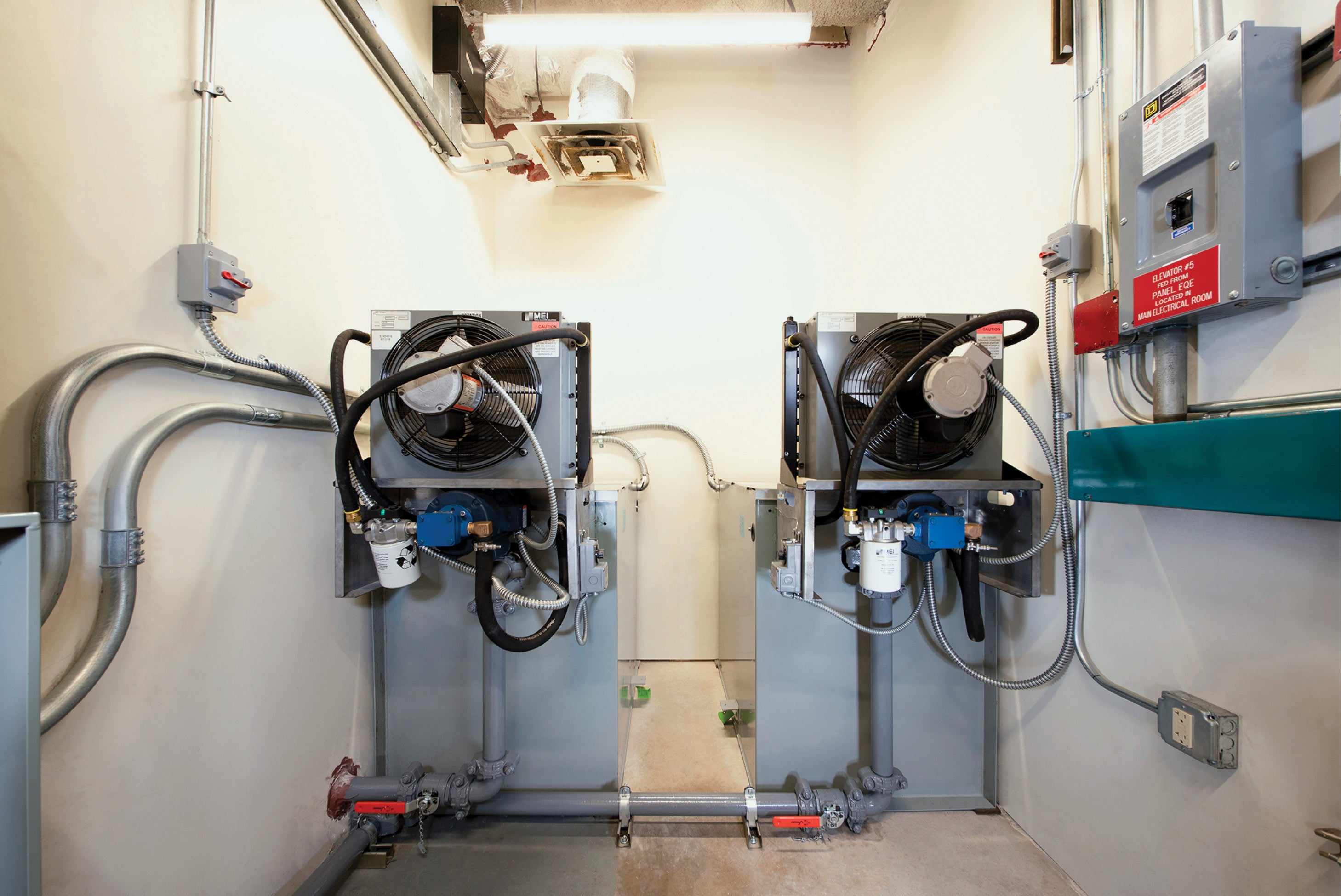
A modernized elevator system’s submersible hydraulic power unit with oil coolers installed.
Image courtesy of Henderson Building Solutions
Typically, a full modernization takes one to three weeks longer than a mini-mod. The elevator carriage, counterweight (if applicable) and interiors are often retained during a modernization, but interior upgrades can become part of a modernization project if desired. Most jurisdictions consider a full modernization as justification to bring the entire elevator installation, including all MEPF and architectural features, up to the most modern codes applicable.
In cases where elevator capacity or speeds of travel are changing, this will bring a full replacement into the fold. There are also instances when elevators are changed from one type (e.g., hydraulic, traction or MRL) to another. A full replacement of the elevator system will require entirely new elevator equipment but will also often require structural changes and replacement of elevator car guide rails, cross beams and other members. The elevator carriage and cab will also be replaced in full during an elevator replacement.
Currently, supply chain disruptions are causing parts for servicing elevators as well as modernization and replacement parts to be delayed for months at a time. Stocking additional service parts is a consideration that a third party can help to evaluate. Like so many other building systems, volatility in elevator commodities markets has caused serious increases in the cost of obtaining material for an elevator project.
Additionally, there is a shortage of labor for highly trained service technicians. This has led to the remaining technicians being scheduled for higher volumes of units in the same time frame. Facilities managers are left to verify for themselves or partner with an independent third party to ensure they are receiving everything in their contracts. Labor shortages on the modernization side also extend the time it takes to schedule a project to start.
Maintaining operations
A health care facility can alleviate the stresses of an elevator modernization project by ensuring that elevators still in service are able to achieve maximum uptime through preventive service and by coordinating additional spare parts to be kept on hand during the project.
Meanwhile, modernization and all the architecture, engineering and construction work that goes with it can be competitively bid to ensure the facility gets the most out of its investment.
Tracy Wagoner is senior construction manager, elevator technical manager and associate at Henderson Building Solutions, headquartered in Lenexa, Kan. He can be reached at tracy.wagoner@hendersonbuilding.com.

